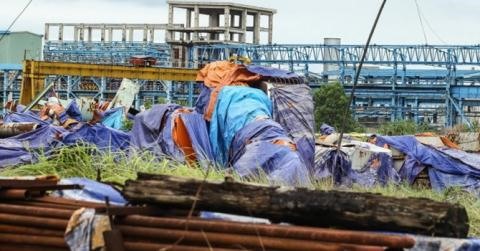 Economy
Economy

The Ministry of Industry and Trade (MoIT) has decided not to rely on 12 steel projects – deemed ineffective – while drawing up its master plan on steel production till 2025.
 |
| A corner of the planned Phase 2 expansion of a plant run by the Thái Nguyên Iron and Steel Corporation in Thái Nguyên Province. — Photo tuoitre.com.vn |
HÀ NỘI — The Ministry of Industry and Trade (MoIT) has removed 12 “ineffective” projects from its latest master plan on steel production that charts a roadmap for the industry until 2025.
These projects, with a total capacity of 6,520 tonnes of steel ingots and 1,350 tonnes of cast-iron and sponge iron, have been removed because of ineffective investments and incapable investors.
Included in the plan are two huge projects: the 1,000-tonne steel ingot factory in Ninh Bình Province, invested in by Kyoei Steel Vietnam Company Ltd.; and Phase 3 expansion of the Thái Nguyên Iron and Steel Corporation in the eponymous province, with an estimated annual capacity of 1,000 tonnes of cast-iron and sponge iron and 1,000 tonnes of steel ingots.
Two steel companies in Hậu Giang Province, funded by Vietnam Steel Corporation, and the HK and CLC steel factory, jointly funded by Thủ Đức and Biên Hòa steel companies, both designed to produce 1,000 tonnes of steel ingots annually, are also included.
The list of ineffective projects include several proposed by local authorities, like the Lào Cai Steel Ingot Factory, the Thiên Thanh cast-iron factory, the second phase of Vietnam-Italia steel plant; and the Quảng Bình Cast-iron and Steel factory.
Two projects that don’t have investors are the Hà Giang Steel Factory and the Sơn La steel ingot and cast-iron factory in northern Sơn La Province.
The new masterplan (with vision till 2035), estimates production to increase to 21 million tonnes of cast-iron by 2020, 46 million tonnes by 2025 and 55 million tonnes by 2035.
The country’s current production capacity is around 12.57 million tonnes of cast-iron and sponge iron and 12.31 million tonnes of various ingots.
Problem project
The MoIT is looking for capable firms to assess Phase 2 of Thái Nguyên Iron and Steel Corporation’s expansion project in Thái Nguyên Province.
Based on the evaluation, the Ministry will submit a report to the Prime Minister, proposing feasible solutions for the project’s problems.
The expansion project’s Phase 2, with an estimated investment capital of VNĐ3.84 trillion (US$169.3 million), was approved in 2005. Funding of 45 per cent each would come from the Vietnam Development Bank and Vietinbank and 10 per cent from the investor.
Due to price fluctuations and policy changes, the investors adjusted the project’s investment capital, which was then approved at VNĐ8.1 trillion in 2013.
The project includes two main bidding packages. Engineering-procurement-construction (EPC) No. 1 will set up a metallurgy production line in Lưu Xá area with a designed capacity of 500,000 tonnes of steel ingot per year.
EPC package No.2, which will exploit the Tiến Bộ iron mine to the tune of 300,000 tonnes a year, came into effect in May 2014.
Meanwhile, Package No1 has been unfinished and at a standstill since 2012 after Chinese contractor Metallurgical Group Corporation (MCC) left the project.
Phase II of the Thái Nguyên Steel Plant is a project that has raised considerable public concern. It is one of the mega projects of State corporations and groups that many National Assembly deputies and voters recently raised questions about, relating to its sluggish progress, losses and wastefulness.
Answering these questions at the 14th NA last month, Minister Trần Tuấn Anh said the Government had directed relevant ministries to inspect these projects and suggest solutions, including revoking the State’s capital and reclaiming assets, clarifying the responsibilities of the organisation and individuals, and strictly punishing violations. — VNS




